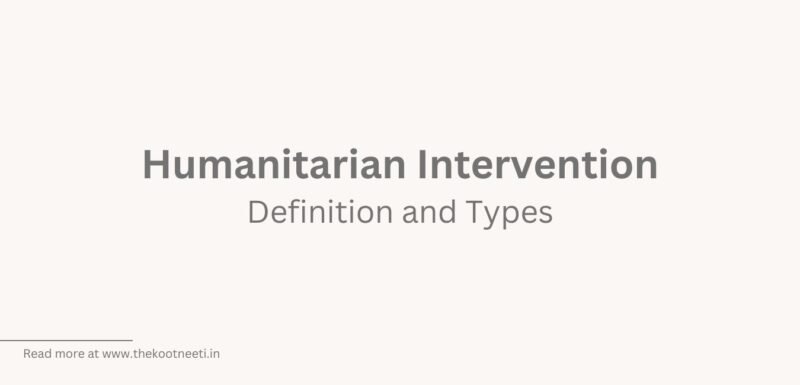Humanitarian Intervention: Definition and Types

Humanitarian intervention refers to the use of military force or other forms of intervention by a state or group of states to address a humanitarian crisis, such as a natural disaster, a genocide, or a mass atrocity. Humanitarian intervention is often justified on the grounds of protecting civilians, preventing human rights abuses, or providing humanitarian assistance to those in need.
Humanitarian intervention has been controversial in international relations, as it raises questions about the appropriate role of the international community in addressing humanitarian crises and about the potential for abuse of such interventions. It has also been criticized for potentially violating the sovereignty of states and for potentially causing more harm than good.
There are a number of international initiatives and agreements that address the issue of humanitarian intervention, including the Responsibility to Protect (R2P) principle, which aims to protect civilians from mass atrocities and other severe human rights abuses, and the United Nations Charter, which allows for the use of military force in certain circumstances to address threats to international peace and security.
There are several types of humanitarian intervention, including:
- Military intervention: This is the use of military force by one or more states to protect populations from harm or abuse. Military intervention can take a variety of forms, ranging from peacekeeping operations to full-scale military invasions.
- Humanitarian assistance: This is the provision of food, medical supplies, and other forms of assistance to populations in need, often in the aftermath of a conflict or disaster. Humanitarian assistance is typically provided by international organizations and NGOs, but states can also play a role.
- Economic sanctions: This is the use of economic measures, such as trade restrictions or asset freezes, to pressure a government to change its behavior or policies. Economic sanctions can be used as a form of humanitarian intervention if they are targeted at specific individuals or groups who are responsible for human rights abuses.
- Diplomatic intervention: This is the use of diplomatic efforts, such as mediation or the threat of diplomatic isolation, to encourage a government to change its behavior or policies. Diplomatic intervention can be an effective way to address human rights abuses without resorting to military force.
There are a range of options available for humanitarian intervention, and the most appropriate course of action will depend on the specific context and needs of the situation.
Humanitarian intervention by UN
The United Nations (UN) has a mandate to promote and protect human rights and to address humanitarian crises around the world. The UN has a number of mechanisms and institutions in place to address humanitarian issues, including the Office for the Coordination of Humanitarian Affairs (OCHA), the United Nations High Commissioner for Refugees (UNHCR), and the World Food Programme (WFP).
The UN also has the authority to authorize the use of military force in certain circumstances, such as to address threats to international peace and security or to protect civilians from mass atrocities and other severe human rights abuses. The UN has authorized a number of humanitarian interventions in the past, including the deployment of peacekeeping missions and the use of military force to address crises such as civil wars, genocides, and natural disasters.
However, the UN’s ability to respond to humanitarian crises and to authorize the use of military force has been limited by the reluctance of some member states to commit their military resources, and by the potential for vetoes by the permanent members of the Security Council.
The Responsibility to Protect
The responsibility to protect (R2P) is a principle in international law that holds that states have a responsibility to protect their populations from mass atrocities, such as genocide, war crimes, ethnic cleansing, and crimes against humanity. The R2P principle was first articulated by the United Nations (UN) in the 2005 World Summit Outcome Document and has since been endorsed by the UN General Assembly.
The R2P principle is based on the idea that sovereignty is not a license to commit mass atrocities, and that the international community has a responsibility to take action to prevent or halt such atrocities when they occur. The R2P principle sets out a hierarchy of measures for addressing mass atrocities, starting with the primary responsibility of the state to protect its own population, followed by the responsibility of the international community to assist the state in fulfilling this obligation. If a state is unable or unwilling to protect its population, the international community may have to take more forceful measures, including the use of military force, to protect civilians.
The R2P principle has been invoked in a number of situations, including in response to the genocide in Rwanda and the mass killings in Bosnia in the 1990s. However, the implementation of the R2P principle has been controversial, as it raises questions about the use of military force and the role of the international community in interfering in the internal affairs of states. Overall, the R2P principle is an important tool for addressing mass atrocities and promoting the protection of civilians in situations of conflict and crisis.


















